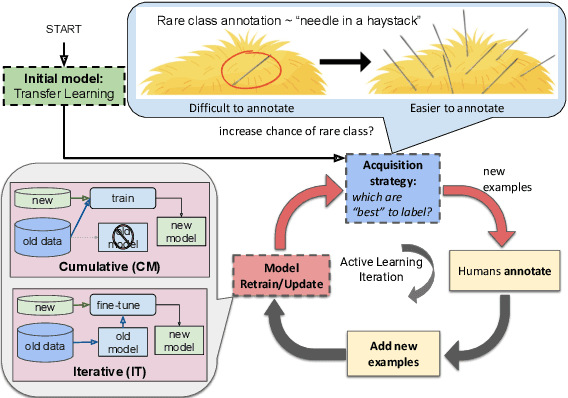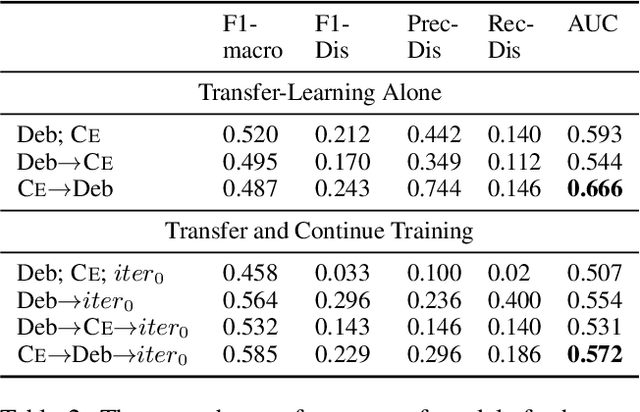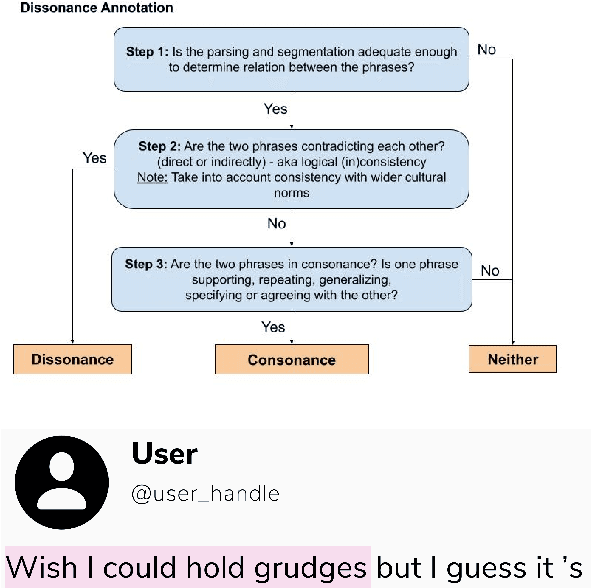Vasudha Varadarajan
ISCA: A Framework for Interview-Style Conversational Agents
Aug 20, 2025Abstract:We present a low-compute non-generative system for implementing interview-style conversational agents which can be used to facilitate qualitative data collection through controlled interactions and quantitative analysis. Use cases include applications to tracking attitude formation or behavior change, where control or standardization over the conversational flow is desired. We show how our system can be easily adjusted through an online administrative panel to create new interviews, making the tool accessible without coding. Two case studies are presented as example applications, one regarding the Expressive Interviewing system for COVID-19 and the other a semi-structured interview to survey public opinion on emerging neurotechnology. Our code is open-source, allowing others to build off of our work and develop extensions for additional functionality.
MAQuA: Adaptive Question-Asking for Multidimensional Mental Health Screening using Item Response Theory
Aug 10, 2025Abstract:Recent advances in large language models (LLMs) offer new opportunities for scalable, interactive mental health assessment, but excessive querying by LLMs burdens users and is inefficient for real-world screening across transdiagnostic symptom profiles. We introduce MAQuA, an adaptive question-asking framework for simultaneous, multidimensional mental health screening. Combining multi-outcome modeling on language responses with item response theory (IRT) and factor analysis, MAQuA selects the questions with most informative responses across multiple dimensions at each turn to optimize diagnostic information, improving accuracy and potentially reducing response burden. Empirical results on a novel dataset reveal that MAQuA reduces the number of assessment questions required for score stabilization by 50-87% compared to random ordering (e.g., achieving stable depression scores with 71% fewer questions and eating disorder scores with 85% fewer questions). MAQuA demonstrates robust performance across both internalizing (depression, anxiety) and externalizing (substance use, eating disorder) domains, with early stopping strategies further reducing patient time and burden. These findings position MAQuA as a powerful and efficient tool for scalable, nuanced, and interactive mental health screening, advancing the integration of LLM-based agents into real-world clinical workflows.
Capturing Human Cognitive Styles with Language: Towards an Experimental Evaluation Paradigm
Feb 18, 2025



Abstract:While NLP models often seek to capture cognitive states via language, the validity of predicted states is determined by comparing them to annotations created without access the cognitive states of the authors. In behavioral sciences, cognitive states are instead measured via experiments. Here, we introduce an experiment-based framework for evaluating language-based cognitive style models against human behavior. We explore the phenomenon of decision making, and its relationship to the linguistic style of an individual talking about a recent decision they made. The participants then follow a classical decision-making experiment that captures their cognitive style, determined by how preferences change during a decision exercise. We find that language features, intended to capture cognitive style, can predict participants' decision style with moderate-to-high accuracy (AUC ~ 0.8), demonstrating that cognitive style can be partly captured and revealed by discourse patterns.
Unifying the Extremes: Developing a Unified Model for Detecting and Predicting Extremist Traits and Radicalization
Jan 08, 2025



Abstract:The proliferation of ideological movements into extremist factions via social media has become a global concern. While radicalization has been studied extensively within the context of specific ideologies, our ability to accurately characterize extremism in more generalizable terms remains underdeveloped. In this paper, we propose a novel method for extracting and analyzing extremist discourse across a range of online community forums. By focusing on verbal behavioral signatures of extremist traits, we develop a framework for quantifying extremism at both user and community levels. Our research identifies 11 distinct factors, which we term ``The Extremist Eleven,'' as a generalized psychosocial model of extremism. Applying our method to various online communities, we demonstrate an ability to characterize ideologically diverse communities across the 11 extremist traits. We demonstrate the power of this method by analyzing user histories from members of the incel community. We find that our framework accurately predicts which users join the incel community up to 10 months before their actual entry with an AUC of $>0.6$, steadily increasing to AUC ~0.9 three to four months before the event. Further, we find that upon entry into an extremist forum, the users tend to maintain their level of extremism within the community, while still remaining distinguishable from the general online discourse. Our findings contribute to the study of extremism by introducing a more holistic, cross-ideological approach that transcends traditional, trait-specific models.
Explaining GPT-4's Schema of Depression Using Machine Behavior Analysis
Nov 21, 2024



Abstract:Use of large language models such as ChatGPT (GPT-4) for mental health support has grown rapidly, emerging as a promising route to assess and help people with mood disorders, like depression. However, we have a limited understanding of GPT-4's schema of mental disorders, that is, how it internally associates and interprets symptoms. In this work, we leveraged contemporary measurement theory to decode how GPT-4 interrelates depressive symptoms to inform both clinical utility and theoretical understanding. We found GPT-4's assessment of depression: (a) had high overall convergent validity (r = .71 with self-report on 955 samples, and r = .81 with experts judgments on 209 samples); (b) had moderately high internal consistency (symptom inter-correlates r = .23 to .78 ) that largely aligned with literature and self-report; except that GPT-4 (c) underemphasized suicidality's -- and overemphasized psychomotor's -- relationship with other symptoms, and (d) had symptom inference patterns that suggest nuanced hypotheses (e.g. sleep and fatigue are influenced by most other symptoms while feelings of worthlessness/guilt is mostly influenced by depressed mood).
Adaptive Language-based Mental Health Assessment with Item-Response Theory
Nov 11, 2023Abstract:Mental health issues widely vary across individuals - the manifestations of signs and symptoms can be fairly heterogeneous. Recently, language-based depression and anxiety assessments have shown promise for capturing this heterogeneous nature by evaluating a patient's own language, but such approaches require a large sample of words per person to be accurate. In this work, we introduce adaptive language-based assessment - the task of iteratively estimating an individual's psychological score based on limited language responses to questions that the model also decides to ask. To this end, we explore two statistical learning-based approaches for measurement/scoring: classical test theory (CTT) and item response theory (IRT). We find that using adaptive testing in general can significantly reduce the number of questions required to achieve high validity (r ~ 0.7) with standardized tests, bringing down from 11 total questions down to 3 for depression and 5 for anxiety. Given the combinatorial nature of the problem, we empirically evaluate multiple strategies for both the ordering and scoring objectives, introducing two new methods: a semi-supervised item response theory based method (ALIRT), and a supervised actor-critic based model. While both of the models achieve significant improvements over random and fixed orderings, we find ALIRT to be a scalable model that achieves the highest accuracy with lower numbers of questions (e.g. achieves Pearson r ~ 0.93 after only 3 questions versus asking all 11 questions). Overall, ALIRT allows prompting a reduced number of questions without compromising accuracy or overhead computational costs.
Transfer and Active Learning for Dissonance Detection: Addressing the Rare-Class Challenge
May 05, 2023



Abstract:While transformer-based systems have enabled greater accuracies with fewer training examples, data acquisition obstacles still persist for rare-class tasks -- when the class label is very infrequent (e.g. < 5% of samples). Active learning has in general been proposed to alleviate such challenges, but choice of selection strategy, the criteria by which rare-class examples are chosen, has not been systematically evaluated. Further, transformers enable iterative transfer-learning approaches. We propose and investigate transfer- and active learning solutions to the rare class problem of dissonance detection through utilizing models trained on closely related tasks and the evaluation of acquisition strategies, including a proposed probability-of-rare-class (PRC) approach. We perform these experiments for a specific rare class problem: collecting language samples of cognitive dissonance from social media. We find that PRC is a simple and effective strategy to guide annotations and ultimately improve model accuracy while transfer-learning in a specific order can improve the cold-start performance of the learner but does not benefit iterations of active learning.
 Add to Chrome
Add to Chrome Add to Firefox
Add to Firefox Add to Edge
Add to Edge